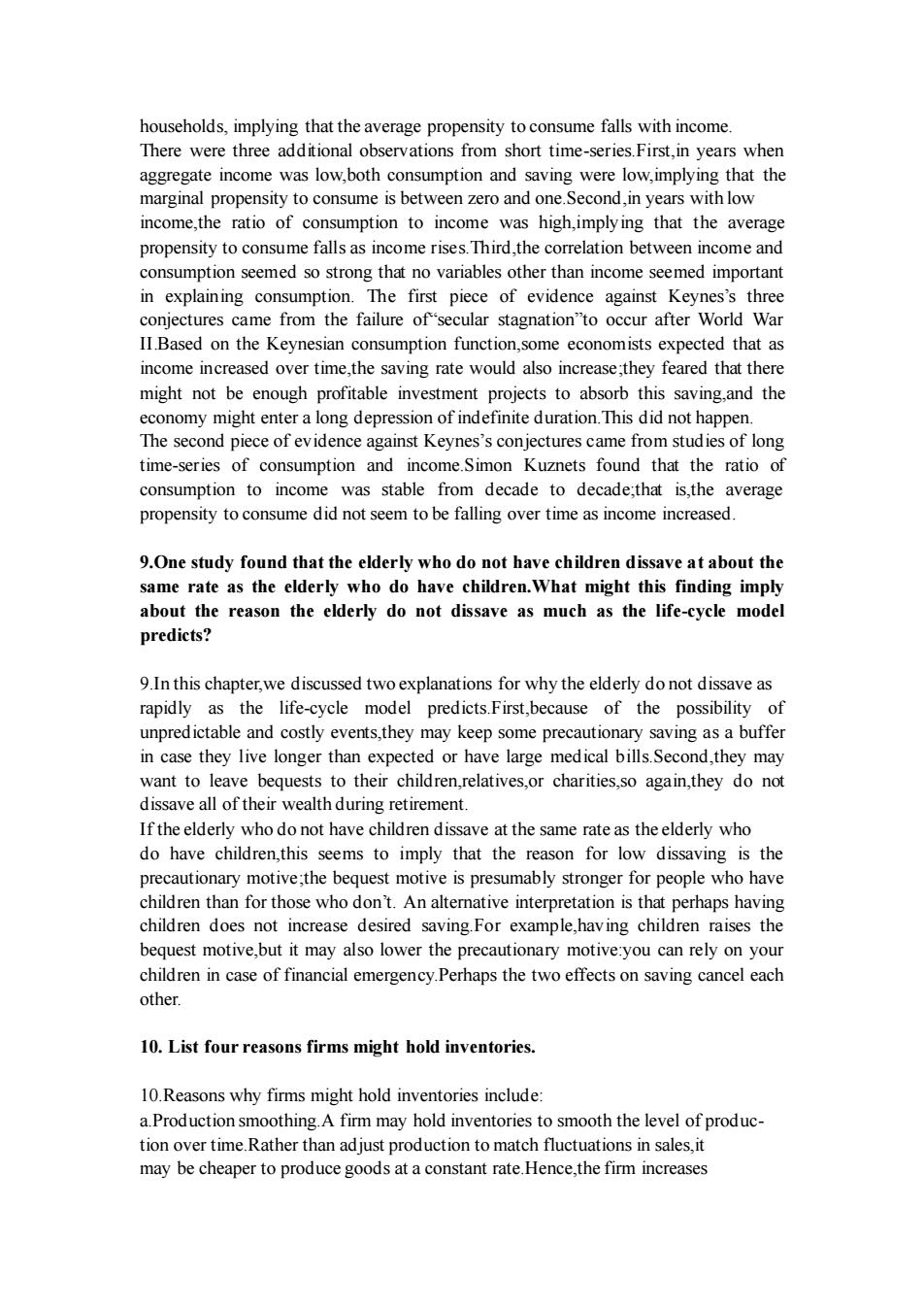正在加载图片...

households,implying that the average propensity to consume falls with income There were three additional ob servations from short time-series First,in year s wher aggregate income was low,both consumption and saving were low,implying that the marginal propensity to consume is between zero and one.Second in years with low income,the ratio of consumption to income was high,implying that the average propensity to consume falls as income rises.Third,the correlation between income and nsum tior emed gthat no variables other than in med impo in explaining consumption The first piece of evid ence against conjcureame rom the faiurecroaferWorld War thre II Based on the Keynesian consumption function,some economists expected that as income increased over time,the saving rate would also increase;they feared that there might ot beou profitable investment this saving.and the ong depression of indefinite duration.This did not h eoevidence inst Keynes's conjectures came from studes of long er al pper time-series of consumption and income.Simon Kuznets found that the ratio of consumption to income was stable from decade to decade;that is,the average propensity to consume did not seem to be falling over time as income increased. 9.One study found that the elderly who do not have children dissave at about the same rate as the elderly who do have children.What might this finding imply about the reason the elderly do not dissave as much as the life-cycle model predicts? 9.In this chapter,we discussed two explanations for why the elderly do not dissave as rapidly as the life-cycle model predicts.First,because of the possibility of unpredictable and costly events,they may keep some precautionary saving as a buffer in case they live longer than expected or have large medical bills Second,they may want to leave bequ ests to their children,relatives,or charities,so again,they do not dissave all of thei wealth during rem Ifthe elderly who do not have children dissave at the same rate as the elderly who do have children,this seems to imply that the reason for low dissaving is the precautionary motive;the bequest motive is presumably stronger for people who have children than for those who don't An alternative interpretation is that perhaps having children does not increase desired saving For examplehaving children raises the bequest motive,but it may also lower the precautionary motive:you can rely on you children in case of financial emergency.Perhaps the two effects on saving cancel each other. 10.List four reasons firms might hold inventories 10.Reasons why firms might hold inventories include a.Production smoothing.A firm may hold inventories to smooth the level of produc- tion over time.Rather than adjust production to match fluctuations in sales,it may be cheaper to produce goods at a constant rate.Hence,the firm increases households, implying that the average propensity to consume falls with income. There were three additional observations from short time-series.First,in years when aggregate income was low,both consumption and saving were low,implying that the marginal propensity to consume is between zero and one.Second,in years with low income,the ratio of consumption to income was high,implying that the average propensity to consume falls as income rises.Third,the correlation between income and consumption seemed so strong that no variables other than income seemed important in explaining consumption. The first piece of evidence against Keynes’s three conjectures came from the failure of“secular stagnation”to occur after World War II.Based on the Keynesian consumption function,some economists expected that as income increased over time,the saving rate would also increase;they feared that there might not be enough profitable investment projects to absorb this saving,and the economy might enter a long depression of indefinite duration.This did not happen. The second piece of evidence against Keynes’s conjectures came from studies of long time-series of consumption and income.Simon Kuznets found that the ratio of consumption to income was stable from decade to decade;that is,the average propensity to consume did not seem to be falling over time as income increased. 9.One study found that the elderly who do not have children dissave at about the same rate as the elderly who do have children.What might this finding imply about the reason the elderly do not dissave as much as the life-cycle model predicts? 9.In this chapter,we discussed two explanations for why the elderly do not dissave as rapidly as the life-cycle model predicts.First,because of the possibility of unpredictable and costly events,they may keep some precautionary saving as a buffer in case they live longer than expected or have large medical bills.Second,they may want to leave bequests to their children,relatives,or charities,so again,they do not dissave all of their wealth during retirement. If the elderly who do not have children dissave at the same rate as the elderly who do have children,this seems to imply that the reason for low dissaving is the precautionary motive;the bequest motive is presumably stronger for people who have children than for those who don’t. An alternative interpretation is that perhaps having children does not increase desired saving.For example,having children raises the bequest motive,but it may also lower the precautionary motive:you can rely on your children in case of financial emergency.Perhaps the two effects on saving cancel each other. 10. List four reasons firms might hold inventories. 10.Reasons why firms might hold inventories include: a.Production smoothing.A firm may hold inventories to smooth the level of production over time.Rather than adjust production to match fluctuations in sales,it may be cheaper to produce goods at a constant rate.Hence,the firm increases